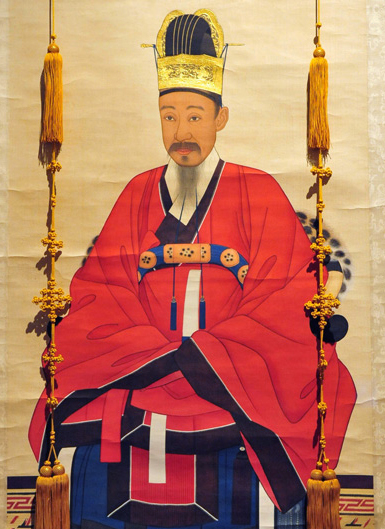Unhyeongung, The Hall of the Korean royal family culture.
We would like to give a warm welcome to all visitors of Unhyeongung.
We invite you to check out Unhyeongung and the history behind the palace, architecture, and tourist information.



Joseon Dynasty's Royalty/Politician. Signature name is Sibaek, pen name is Sukpa, and his given name was Ha-eung. He was a 5th generation descendant of King Youngjo and Joseon's 26th King Gojong's father. In 1843 (Hunjong 9th), he was appointed to Heungseon Gun (Prince of the Great Court) and in 1846, he became Daejon Gwan (high official) of Sureung Chunjangdogam (government office for royal marriages and funerals). He then held the titles of Yusadangsang (high official) of Jongchin Bu (Royal Government Office) and Dochong Gwan (highest official) of Owe-dochong Bu (highest military command office). As a way to defend himself against the nepotism of the Andong Kim clan and close monitoring of other royals, he hung out with an unruly crowd and even participated in begging. People made fun of this and called him the "PalaceIdiot". He secretly agreed with Queen Jo of the Royal Family to place the second son, Myeong-bok, as the successor to the throne after King Chuljong died without a direct successor and then, he was appointed to Daewongun. Afterwards, through the regency, he was able to push through solid, innovative politics, which broke down nepotism, partisanship, and family ties. The system soon began to favor individual ability and brought order to an unstable educational institute, which was the center of political strife. He blocked the monopoly of landowners and put in place a law (Hopo bub) that taxed both the commoner as well as the nobility, who had previously been exempt. Additionally, a governing system for public food supply was changed from provisions by the Kingdom (Hwangok Je) to the local villages (Sachang Je). The dress code was set to have greater simplicity and overspending was prohibited. He presented books of law such as [Daejunhwaytong], [Yookjunjorae], and [Yangjungpyungo] in order to push towards establishing law and order. In the reconstruction of Gyeongbok Palace, he collected Wannapjun (forced donations collected from the people) and Yeokyeok (forced labor), which resulted in public complaint. Additionally, a Policy of Strict Isolationism was set in place to ward off foreign influences. During Byeongin Bakhae, 9 priests from France and about 8,000 Catholics were executed. These large-scale acts of anti-Catholicism resulted in an invasion from France. The General Sherman Incident brought The United States to strongly request a trade policy, but this was also denied. A power struggle between Queen Myeongseong led to the Confucian Scholars, Cho Ik-hyeon, and others to an appeal, which eventually led to him losing his position. During the Imo Incident of year 82 (Gojong's 19th year), he sought the opportunity to retake his position, but was captured by Qing's intervention and forcibly taken to Tianjin, where he lived a life of imprisonment for 3 years. Afterwards, in year 86, he colluded with Yuan Shikai in a failed attempt to dethrone the oldest son, Jaehwang. In year 95, the Eulmi Incident, instigated by the Japanese Envoy,Miura, resulted in his siege of the regime. The establishment of a friendship amongst the government of Russia based on the Korea Royal Refuge at the Russian legation resulted in his retirement. In 1907 (Sunjong 1st), he was appointed King Daewon. He was granted the title Heonui.
Whanhyeong Gun Lee Jae-myeon was the first son of Hyeongseon Daewongun. Although he was seven years older than his brother Myeong-bok, he was not chosen to be the crown prince. After losing his wife, he remarried the 20-year-old, Gyesil, at age 57. Gyesil was 13 years younger than his son, Lee Jun-young.
Youngsun Gun Lee Jun-yong was the first son of Lee Jae-myeon. He lived in Songjeong Sarang-Chae at the back of Norok Dang before moving to Unhyeongung. In 1896, right after the Eulmi Incident, he went to Japan to study modern sciences and returned to his home country after 12 years in 1908, after which he lived at Unhyeongung. In 1917, he passed away at age 47, 5 years after his father, Lee Jae-myeon's, death. Lee Jun-yong passed away without an heir. Lee Woo, who was son of King Uichin, the fifth son of Gojong, was chosen to be an adopted son. Lee (1883-1978), wife of Lee Jae-myeon, was intended to take care of the household of Unhyeongung, but Gyesil Gwangsan Kim of Lee Jun-yong, who was the granddaughter-in-law of Daewongun, managed all the housework.
Huengyoung Gun Lee Woo was 5 years old when he was adopted by Lee Jun-yong. At age 10, he went to Japan and served in the Japanese Military. The sending of Lee Jun-yong and Lee Woo to Japan was part of a political propaganda. In Japan, Lee Woo married Pak Chan-ju (1914~1995), who was Pak Young-hyo's great-granddaughter.
Lee Woo's eldest son, Lee Chung, is Heungseon Daewongun's 5th generation and Gojong's 4th generation descendant. Outwardly, his appearance show similarities to Gojong and he carries himself as a royal descendant should. Lee Chung grew up in Japan and did not live his childhood at Unhyeongung, but stayed there on occasional trips that were granted to Korea. Lee Chung became the owner of Unhyeongung in 1948. Difficulties in managing Unhyeongung resulted in the City of Seoul taking over management in 1993, and now, it is operating as the Capital of Seoul's 600-Year Anniversary Project.